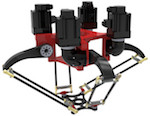Session 1 (9:00–11:45, w/ coffe break at 10:30) - Rigidity Theory
3 invited talks of 35 minutes each focusing on rigidity theory.
Talks will be a blend of both tutorial style and presentation of recent results in the field.
Speaker 1: Daniel Zelazo
Rigidity theory and formation control: A Tutorial: dowload-pdf
Speaker 2: Hyo-Sung Ahn
A physical interpretation of the rigidity matrix: download-pdf
Speaker 3: Shiyu Zhao
Construction of bearing rigid networks in arbitrary dimensions: download-pdf
Interactive Session (11:45–12:30)
The interactive session will be comprised of short 5 minute "teaser" talks followed by "media posters" and informal discussions.
Presenters
- MH Trinh, B-H Lee, PH Hoang, Y-B Bae and H-S Ahn
Distributed bearing-based formation control via orientation estimation
- D Six, A Chriette, S Briot and P Martinet
Design and control of a flying parallel robot
- A Fomin, V Glazunov, J Paik and E Didenko
The design of a new rotary hexapod with a single active degree of freedom
- B-H Lee and H-S Ahn
Distributed control for synchronization on cirlce
Session 3 (14:00–16:45 , w/ coffe break at 15:30) - Parallel Robotics
3 invited talks of 35 minutes each focusing on parallel robotics.
Talks will be a blend of both tutorial style and presentation of recent results in the field
Speaker 1: Jean-Pierre Merlet
Structural topology, singularity, and kinematic analysis: download-pdf
Speaker 2: Marco Carricato
Screw theory and its application to robotics: dowload-pdf
Speaker 3: Sébastien Briot
How theory on parallel robot singularities was used in order to solve sensor-based control problems: dowload-pdf
Panel Discussion (16:45–17:30)
A focused panel discussion aimed to wrap up the various contributions and discuss possible concrete ways of cross-exploiting tools/ideas from the two communities.
